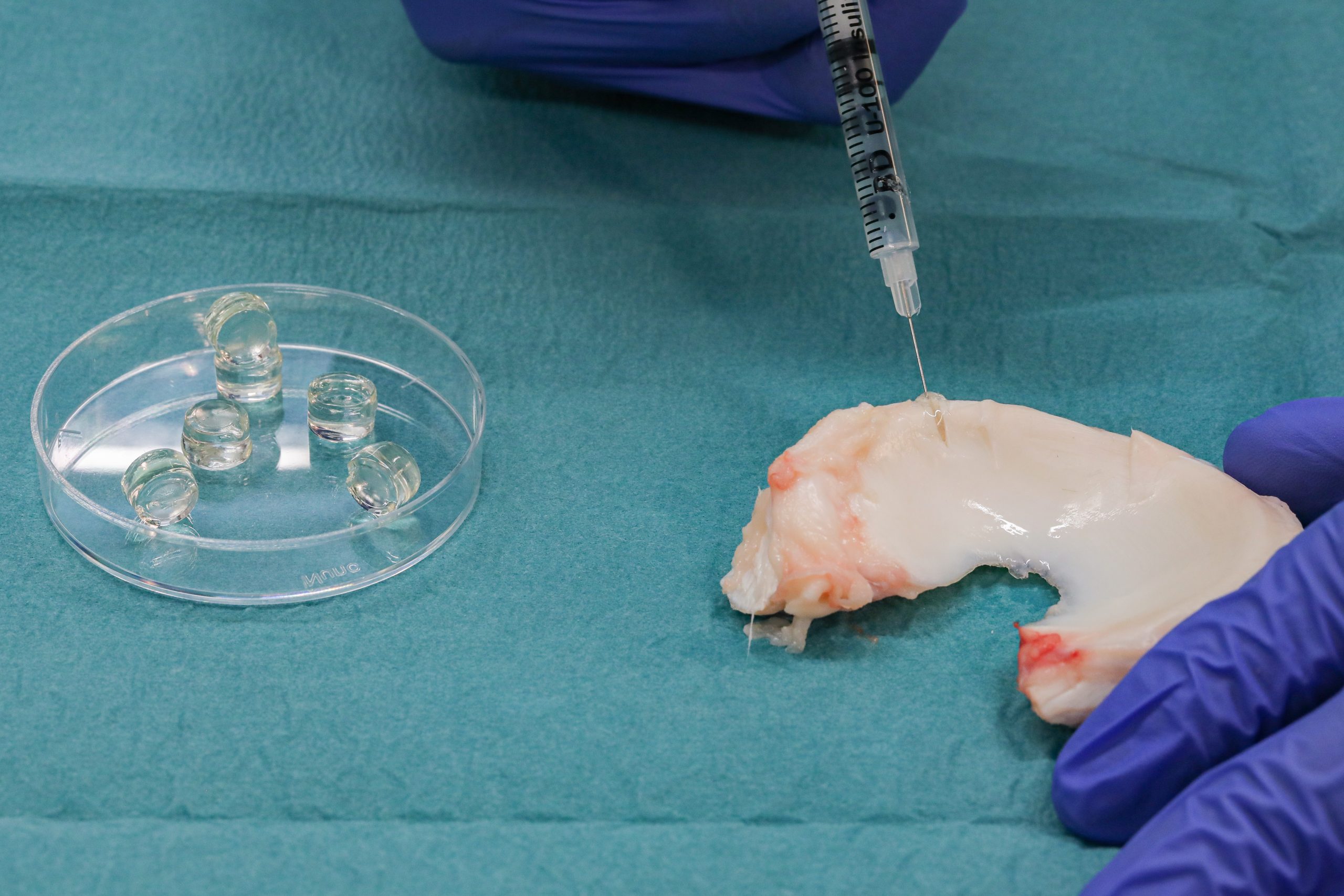
Even with recent successes in medical innovations, there are still some injuries with limited answers. Take having to repair a torn meniscus, for example. Though some of these tears heal on their own, often people must get a complicated surgery that involves sewing together the cartilage. A new hydrogel can glue these tears back together. It is being developed by scientists at the École polytechnique fédérale de Lausanne (EPFL).
Meniscus tears are caused by a forceful turning of the knee and are common on the football field and the skill hill. They are also quite prevalent in the Netherlands – about 30,000 meniscus surgeries happen every year.
Soft tissue tears are generally healed by a suture – or stitches that bind together the tear. Because they involve puncturing the tissue, sutures may result in further complications and incomplete healing. Repairing a meniscus tear, for instance, can lead to osteoarthritis. On the skin, a suture is relatively simple. With soft-tissue, it is like having to sew together a delicate piece of gelatin. A more visceral example is stitching one’s eye.
But if stitches themselves are the limitation, why not another method – say, gluing the tissue together?
With this hydrogel, we can target more challenging applications for where there is no existing solution
Peyman Karami, Doctoral Assistant at the EPFL Biomechanical Orthopedics lab
Hydrogels
Enter hydrogels: medical adhesives meant to fuse tissue together in a way that is more ‘natural’. They work similarly to using an epoxy to reattach a wing to an airplane – rather than welding it on. Hydrogels provide a way of repairing soft tissue damage that is more seamless.
For years, scientists have tried to develop a hydrogel that is strong, safe, and binds well with torn tissue. Researchers at the EPFL Laboratory of Biomechanical Orthopedics (LBO) have developed a family of hydrogels that are strong, non-toxic, and are able to form within an affected area without any extra surface treatment.
“This is the holy grail of biomedical materials,” says Dominique Pioletti, Associate Professor and head of the LBO. “If you can use a glue instead of a suture – that would ease your life a lot.”
Intrinsically adhesive hydrogel
The hydrogel can contain biological cells and is photo-curable. This means that it starts in a liquid form and then uses visible light to solidify into a gel. It is injected into an affected area and forms to fill the space created by the tear. Think of how a liquid sealant might be used to fill a crack in leaky pipe. This works in a similar way. It then uses encapsulated cells to ‘naturally’ reattach and form new tissue.
“That’s why we call these ‘intrinsically adhesive’ hydrogels,” explains Peyman Karami a postdoc at Pioletti’s lab who developed the gel during his PhD.

Since the hydrogel is mostly made of water, it can have drugs dissolved inside prior to it being injected into a laceration or tear. These stimulate the healing process, especially useful for soft tissues that do not heal on their own. It is also biodegradable and can be controlled to dissolve over the course of days or months – depending on the severity of the injury.
Karami developed the hydrogel as a means of healing more delicate parts of the body. For example, he has tested it on the heart, lung, kidney, and liver.
“What is more interesting is that, with this hydrogel, we can target more challenging applications for where there is no existing solution,” says Karami.
Certain tears in cartilage and eye tissue present such a challenge. To wit, his hydrogel can bring new hope to those who have damaged soft tissue in ways beyond conventional repairs. In order for that to happen, it would first need to be adopted in hospitals.
An evolution – not a revolution
“If you want to develop something that is successful, you need an evolution and not a revolution,” says Pioletti. “That means it should be self-evident for the surgeon to use it, even if it is a new product.”
The hydrogels have been developed to be easily adopted by surgeons in soft-tissue surgeries. Moreover, they may widen the competency threshold for these surgeries to those with less proficiency in these areas.
“You have to be a very skilled surgeon for meniscus surgeries,” explains Pioletti. “The demanding skill of suturing in a complicated situation would be made easier because you wouldn’t need that skill anymore.”
For patients, this could mean lower wait times for surgeries such as these since more surgeons could administer the gel. However, to have something that is closer to a revolution, the two first need to prove that their hydrogel is not just faster and easier – but better at repairing the tissue.
Five years away
Though Pioletti believes that on average the results from the hydrogel would be superior, more testing is needed. Specifically, the next step is using the hydrogel on injured animals to see how they heal. They have already tested the hydrogel on the knees of goats. They found that within two days, the adhesive was strong enough for them to roam free in a barn.
Pioletti’s lab has just received an Innosuisse grant to study potential orthopedic applications in association with surgeons at the Lausanne University Hospital (CHUV). They hope to be able to launch their hydrogel on the market within the next five years.
Read about how tooth generation could soon be a reality.




